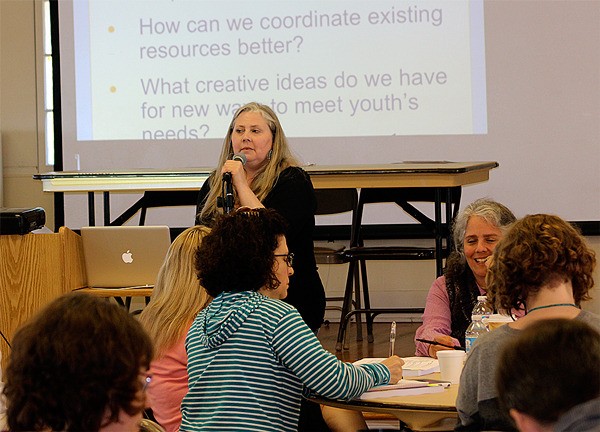Nearly 400 Whidbey residents between the ages of 12-24 reported experiencing homelessness within the past year, according to the results of a recent island-wide youth perception survey.
The survey was one of two conducted by local service providers and school district liaisons in January, partnered by a community perception survey for those 25 and older.
As of Wednesday, 2,349 individuals responded, of whom 378 indicated having been homeless at some point within the last 12 months.
According to school district liaisons, 104 of these young people were unaccompanied.
THESE FINDINGS, as well as other information pertaining to youth homelessness in Island County, were the focus of discussion at the Whidbey Island Homeless Youth Task Force Forum Wednesday.
Last fall, Ryan’s House for Youth, the SPIN Cafe and homeless liaisons for Whidbey schools cooperated to establish a homeless youth task force, which will facilitate bi-monthly meetings at which homeless young people can share their stories, express their concerns and discuss their greatest needs.
Ryan’s House for Youth, the island’s homeless youth advocacy organization, and Vivian Rogers-Decker, homeless liaison for the Oak Harbor School District, received a two-year grant from the National Association for the Education of Homeless Children and Youth in the amount of $3,000 annually.
The grant funds costs such as transportation of youth to and from the meetings, and food for attending youth.
AT WEDNESDAY’S forum, representatives from local and national organizations, as well as government agencies and community groups, convened for a four-hour conference to converse about the most prevalent issues facing Whidbey’s homeless young people, and to collectively brainstorm means by which to better assist them.
Bill Walker, who attended the forum as an independent citizen, remarked that a fellow attendee told him, “I’m here because it’s not right that we live in a world where we treat our kids worse than we treat our dogs.”
Three formerly homeless young people were also in attendance, and led a panel discussion offering first-hand insight into the causes and effects of youth homelessness, as well as the best ways community members can help them.
Each of the students had received help from Ryan’s House for Youth and volunteered to speak in order to foster a better understanding of the realities faced by those in their former situation.
“A LOT of what it took away from me was my worth and how I felt about myself,” one young man said, recalling that people seemed to regard him as “another thrown away, wasted youth.”
“That’s what hurt me more than going hungry. That’s what hurt me more than being cold,” he added. “I knew that society looked down on me because of situations that were not even my fault.”
A second young man echoed this sentiment, explaining that the perception of homeless individuals is usually negative, and often involves stereotypes.
“The general perception is that there is something obviously wrong with you, but that isn’t always the case,” he said.
PERCEPTION WAS a main point of discussion, as the youth pointed out children are often conditioned from a young age to look down upon those who are destitute.
Community members, they said, can help by changing the way society regards homelessness, and by individually and collectively taking a part in the effort to help in whatever ways possible.
The majority of youth perception survey-takers indicated that they were between the ages of 11-18; 69 percent of responses gathered by school district liaisons were from survey-takers under the age of 15. According to the survey, 61 homeless youth reside in Coupeville, while 222 are in Oak Harbor and 84 in South Whidbey.
About 40 percent were female, 55 percent male, and five percent identified as other.
PRESENTERS STRESSED that the results of the survey do not necessarily reflect the total number of homeless youth on Whidbey, as some choose not to self-report.
The reasons youth become homeless are numerous. Some are ejected due to family poverty, while others are kicked out when they become pregnant. According to the Williams Institute at the University of California, 40 percent of homeless youth are LGBT.
Though one audience member piped up to note it is illegal to kick teens out of the house before their eighteenth birthday, Vivian Rogers-Decker, school district homeless liaison, acknowledged that while this is true, the law isn’t a deterrent to many parents.
Many unaccompanied homeless youth leave voluntarily, fleeing abusive or otherwise toxic households.
ACCORDING TO the U.S. Department of Health and Human Services, one study found that 46 percent of runaway and homeless youth had been physically abused, and 17 percent had been forced into unwanted sexual activity by a family or household member.
Forum presenters said that studies show an even greater number, between 20 to 50 percent of unaccompanied homeless youth, have been sexually abused.
Other key findings of the survey specified the respondents’ greatest needs, such as transportation, food, safe and stable housing, or a supportive adult guardian.
Food and clothing were ranked top priority, followed by stable and safe shelter. For youth old enough to work, employment was also high on the list.
IN TERMS of solutions, attendees and facilitators reached a consensus that a few items are promptly needed, including: an accessible listing of services available to youth, possibly to be posted at bus stops or on small fliers; more coordination between social service providers to establish plans to assist individual youth; and the possibility of a community-funded contract with a local taxi company to offer free rides to unaccompanied homeless youth who need a ride when the bus is not available, such as in the evening or during the weekend.
Attendees also agreed that the voices and perspectives of youth, both currently and formerly homeless, will be integral moving forward.
“There’s a sense that if you have need, you should be ashamed to go and get help,” Rogers-Decker said.
“We are trying to normalize that need.”



